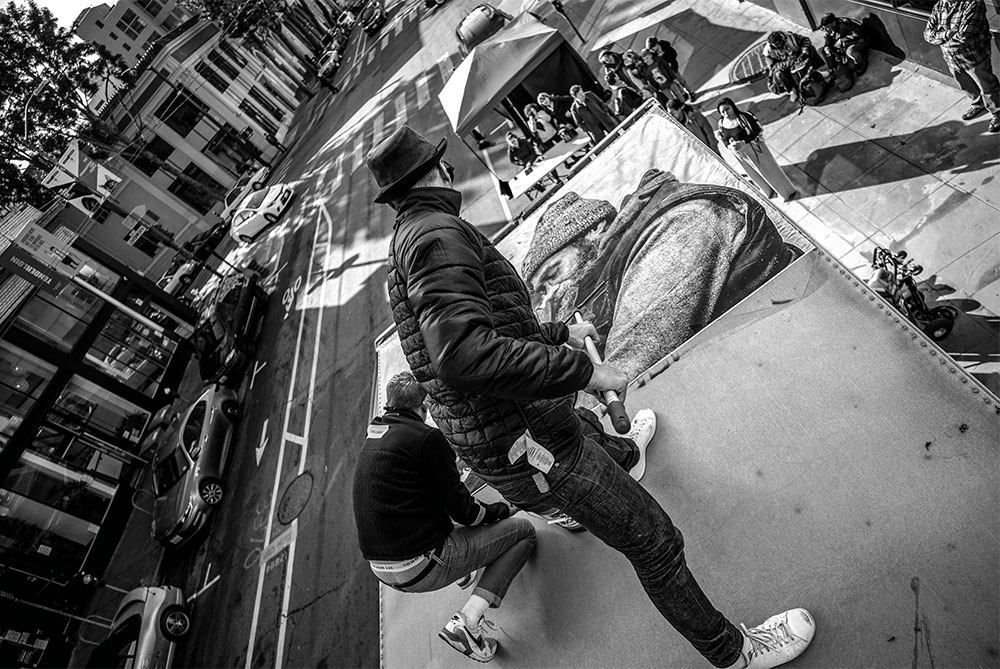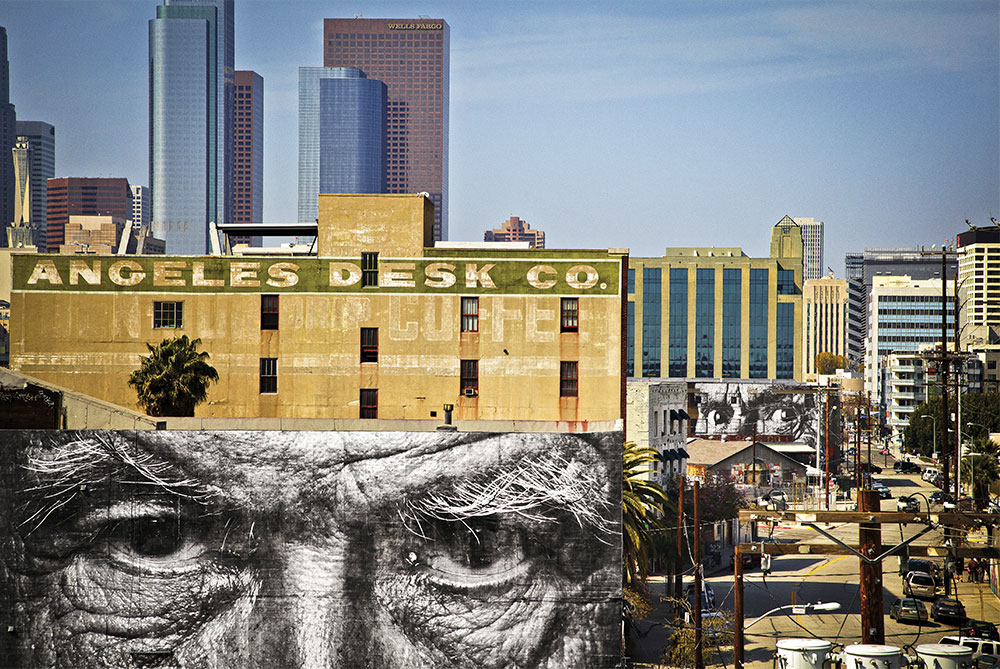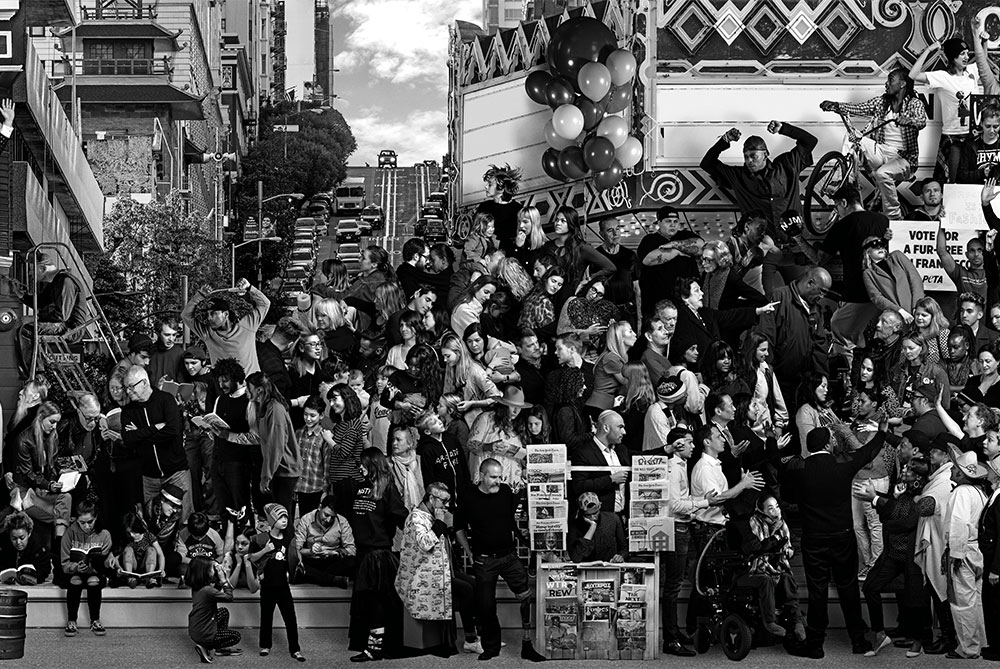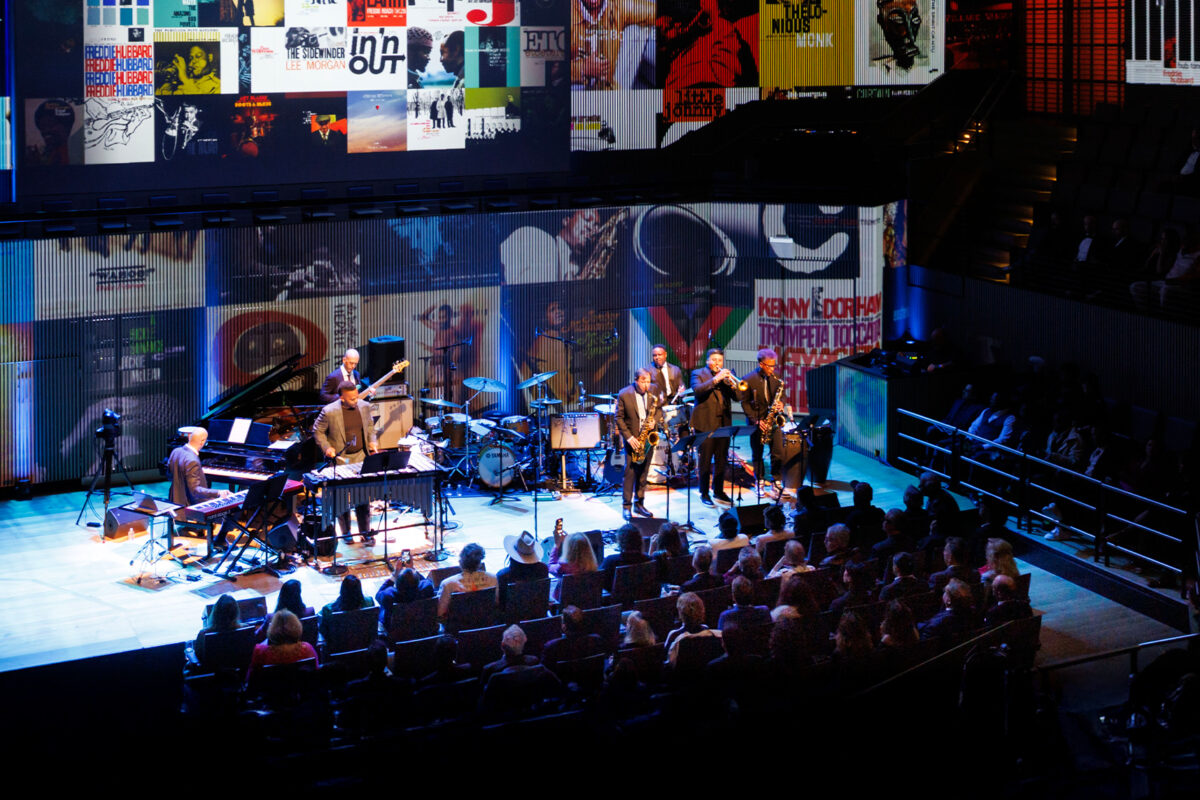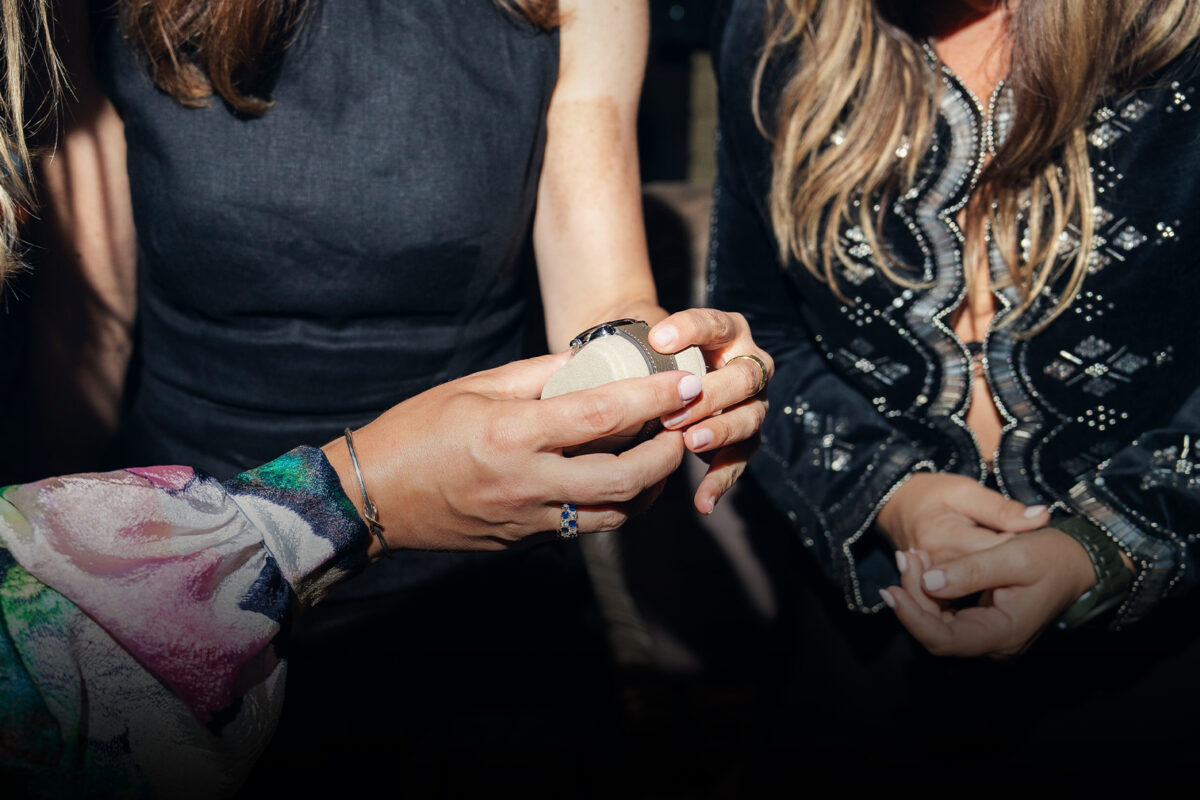World-renowned artist JR captures the essence of San Francisco and puts it all on display
Words by ELIZABETH KHURI CHANDLER
The vibe at 11 p.m. at the San Francisco Public Library’s Night of Ideas, a February evening devoted to debate, readings and performance, is bustling. People cram in front of a makeshift stage and wander the stacks, munching on doughnuts and carrying plastic cups of wine, while members of the Bandaloop dance group scale the walls like giant bugs.
Into this rowdy milieu bounds the French artist known only as JR, famous worldwide for his larger-than-life photographs splashed graffiti-style across buildings, trains and staircases — all of which embrace the idea of a universal community. He has pasted giant pictures of Israelis and Palestinians next to each other in eight Palestinian and Israeli cities. His “Kikito” installation of a giant photograph of a Mexican child peeking over the U.S.-Mexico border fence is iconic. And his collaboration with Time magazine, for which he interviewed and photographed 245 people on both sides of the gun control issue, ranging from professional marksmen to trauma nurses who treat shooting victims, is highly provocative. Suddenly, you’re forced to see your neighbors.
Tonight he’s wearing his trademark sunglasses, a kooky little fedora, head-to-toe denim and combat boots. As he takes the audience through a tour of his body of work on a big screen — beginning with his early pieces in Les Bosquets, the “ghetto” of Montfermeil, a suburb east of Paris — his commentary is filled with such cheerful asides as, “The mayor sued me!” He’s irreverent and funny, sharp and easygoing. You get the impression he’s enjoying this ride but, like a true graffiti artist, could vanish at a moment’s notice.
On May 23, he debuts a work that reflects the unique melting pot that is San Francisco. On view in the San Francisco Museum of Modern Art’s Roberts Family Gallery (which the public can access for free) through April 27, 2020, The Chronicles of San Francisco is a mural inspired by Diego Rivera’s work but very much of the current time. Instead of frescoes of lumberjacks and farm workers, he’s created a 17-foot-by-100-foot digital video collage of 1,206 people he collected at random from the city’s streets.
“I had come to San Francisco many times, but I never understood the city,” he says. “All the technology comes from here. Diego Rivera had painted here. I started scouting and realized … this city has incredible freedom … and at the same time this homeless situation.”
“I just see people. That’s how I approach my work everywhere — Kenya, Liberia, here in San Francisco”
So, in January and February of 2018, JR loaded up a giant 53-foot trailer-truck with photographic and audio equipment and traveled to 22 different locations in San Francisco, from Ocean Beach to Bayview, inviting passersby to be photographed and filmed. People who follow his work also sought him out. When they showed up he asked them how they wanted to be portrayed.
“Many people were just walking by and had not heard of the project. Or of me,” he notes. “They had to decide how they wanted to be represented — forever. Some were like, ‘Can I be drinking?’ Others said, ‘Can I be on the phone?’ ‘Can I be dancing?’”
He filmed each person in front of a green screen, which he used later for the collage component. Then he ushered them outside to record their audio file and share whatever they wanted. People told him how proud they were of the city, or how the city has changed; others spoke of the city’s homeless population.
For JR, it is extremely important there is no illusion of hierarchy. As a multiracial person (his father French, his mother Tunisian), he grew up in the suburbs of Paris where people came from all over the world. “I realized that home is everywhere, and I never see social class, or rich or poor, or black or white,” he says. “I just see people. That’s how I approach my work everywhere — Kenya, Liberia, here in San Francisco.” The 36-year-old currently works from his studio in New York.
Artistically, that means every subject is photographed at the exact same size, all in focus, and in the same light (no one is shaded or brighter than another person). Afterward, everyone was collaged together for a looped video composite that calls to mind the surreal whirly-swirly paintings of Hieronymus Bosch. A unicorn is inserted among the masses (a play on startups valued at $1 billion or more). There are homeless people, tech entrepreneurs, cross-dressers, dancers and firefighters. Each of the 1,206 individuals and groups has its own video loop so nothing repeats with any predictability. It’s a seething mass of humanity.
Michael Birch, founder of social networking site Bebo and members club The Battery, was invited to participate by friend Marc Benioff, founder and co-CEO of software company Salesforce. Benioff invited his entire CEO dinner club group, which includes Drew Houston, founder of file sharing service provider Dropbox, and Nirav Tolia, founder of social networking site Nextdoor, among others, to participate (at the time the truck was parked in front of the Salesforce headquarters). Birch’s pose was a reaction to the recent election of President Donald Trump; he is seen scratching his head.
Other notables pepper the mural: Julia Hartz, co-founder and CEO of ticketing service Eventbrite; Golden State Warriors basketball player Draymond Green; restaurateur Michael Mina; and California Governor Gavin Newsom. There’s even an homage to the late Mayor Ed Lee. “We wanted mayors,” says JR, who famously got the aforementioned French mayor, who sued him, to pose for another mural he made for the town after the riots in Les Bosquets. And there are names that don’t ring a bell: clinical research technical coordinator and homeless advocate Guiseppe Cavaleri, Salesforce employee and Afghan Refugee Islamic Community volunteer Brielle Nikaido, and a longtime S.F. resident who goes by the moniker Catbird. “There’s no rich or poor, there’s no black or white. They’re just people,” JR says. “By mirroring the people, suddenly you realize what they’re part of. Often that’s all we need to remember. Oh yes, we’re all in this together.”
The director of SFMOMA, Neal Benezra, says, “I value the fundamentally inclusive and populist character of JR’s work … The Chronicles of San Francisco includes all aspects and communities of our city. All too often the art world is seen as exclusive and out of the reach of so many sectors of society, and I am thrilled that SFMOMA can engage individuals from all walks of life in this ambitious work.”
“By mirroring the people, suddenly you realize what they’re part of”
JR also wants his subjects to interact with his work, to feel an ownership. The filter between his work and the public is very thin — no brands or galleries are involved (he relies on private donations) — which harks to his roots as a teenage graffiti artist. For his Women Are Heroes project in 2008, he pasted images of women’s faces and eyes on the stairways and buildings of the Morro da Providência in Rio de Janeiro. The next day, all the images were scratched. But he liked that — it showed that people living there felt like the art was their own. In March, his installation at the Louvre was destroyed by pedestrians within a day.
For The Chronicles of San Francisco, you can touch a person’s face, hear their audio story and watch their movements. “You’ll never know if you’ll change people’s minds,” JR says. “But sometimes you can change the perspective of how people see things, and that’s a way of changing people’s minds.”
This story originally appeared in the Spring 2019 Men’s Edition of C magazine.

